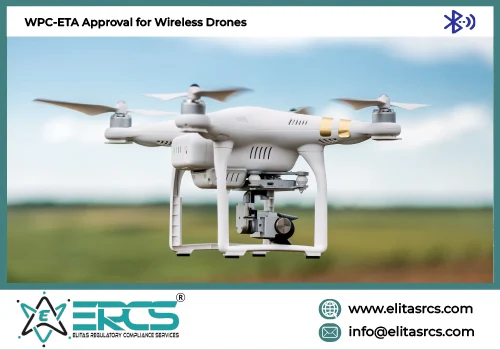WPC Approval (ETA) for
Wireless Drones in India

WIRELESS DRONES
Wireless Drones are often referred to as unmanned aerial vehicles (UAVs), have been more popular for use in a variety of contexts, including security, agriculture, package delivery, and even entertainment. The Qi Standard, Power Transfer Efficiency, Foreign Object Detection, and Safety Standards are some of the technical requirements that makers of wireless drones need to fulfil in order to get WPC certification for their products. In addition, in order to run an operation that is both safe and responsible, they need to comply with other regulatory agencies like the FAA and the ICAO. It is vital to get WPC certification in order to assure conformity with international standards and to guarantee that the goods are safe and trustworthy. In recent years, wireless drones have gained growing popularity for a variety of purposes, including surveillance, agricultural, distribution, and entertainment, among others.
In order for manufacturers of wireless drones to get WPC certification for their goods, the manufacturers must guarantee that their devices comply with the following technical specifications:
Qi Standard: The wireless charging technology that is used in the drones is required to be in accordance with the Qi standard that was designed by the WPC.
Power Transfer Efficiency: It is required that the wireless charging technology used in the drones fulfil the minimal requirements for power transfer efficiency that have been set by the WPC.
Detection of Foreign Objects: The wireless charging technology that is utilised in the drones must have the ability to identify foreign items such as metal and immediately cease charging in order to avoid any mishaps.
Requirements for User and Environmental Protection: In order to protect users and the environment from potential harm, the wireless charging system must conform to the safety standards outlined by the WPC.
They are able to carry out a diverse array of responsibilities because to the high-resolution cameras, sensors, and other specialised hardware that may be installed on them. Some of them can fly for many hours on a single battery charge, but others can only do so for a few minutes at a time. Drones that operate wirelessly are outfitted with the ability to communicate wirelessly using technologies such as Wi-Fi, Bluetooth, and cellular networks, in addition to GPS sensors. Despite the numerous advantages they provide, wireless drones also give rise to issues about safety, privacy, and security. With the purpose of ensuring the safe and responsible use of wireless drones, governments and regulatory agencies have devised a set of laws and regulations.
Basic Requirement to get WPC (ETA) approval
Following requirement should be fulfilled by applicant –
Foreign Manufacturers –
Foreign Manufacturer (Applicant) has to appoint Authorized Indian Representative (AIR).
If Foreign Manufacture (applicant) has the Branch office/Liaison office in India then, they can become an AIR.
Domestic Manufacturer –
The domestic (Indian) Manufacturer can directly apply for ETA and import license without nomination of AIR.
Required Documents
For ETA Certificate –
- Copy of Company Registration /GST registration (For address Verification)
- ID and address proof of authorized person
- Radio Frequency (RF) Test report from any foreign laboratory that is ISO 17025 certified or an Indian laboratory that is NABL approved
- Authorization letter (If authorized person is other than CEO)
- Product technical details
For Import License –
- ETA Certificate
- Purchase order
- IEC Certificate
- Proforma Invoice
What is RF (Radio frequency) test report and how to get it?
RF (Radio Frequency) testing is a method of checking the frequency of radio transmissions to ensure that they are efficiently using the spectrum. In order to achieve maximum efficiency, it is essential to ensure that radio waves in the airspace do not conflict with one another.
Manufacturers/ Importer need to get the RF test report from the ILAC/NABL accredited lab for ETA approval to sell the product in India. If the multiple RF modules contains in the particular product, then the test report of all modules to uploaded to get ETA approval.
Process to get Equipment type approval (ETA) from WPC department:
- Checking EN standard and RF testing from AuthorizedLaboratory
- Documents Preparation
- Application Filing to WPC (Online portal generation)
- Submitting the requisite fee online to Govt.
- Application Scrutinization by WPC
- Grant of ETA Certificate by WPC